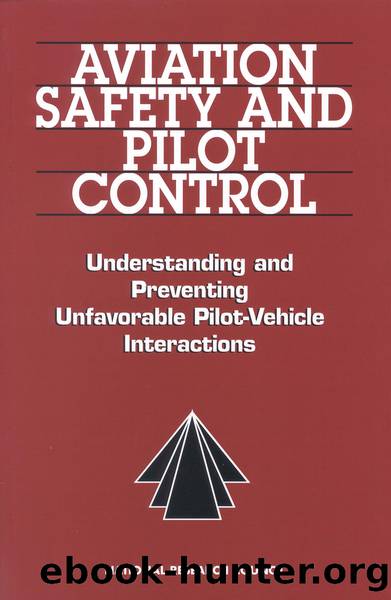Aviation Safety And Pilot Control: Understanding and Preventing Unfavorable Pilot-Vehicle Interactions by Committee on the Effects of Aircraft-Pilot Coupling on Flight Safety

Author:Committee on the Effects of Aircraft-Pilot Coupling on Flight Safety
Language: eng
Format: epub
Tags: Transportation and Infrastructure. Space and Aeronautics : Aircraft and Flight
Publisher: NATIONAL ACADEMY PRESS
Published: 1997-03-05T00:00:00+00:00
Technical Fixes
Careful implementation of recommended processes does not guarantee that APC problems will never be encountered during subsequent analysis and evaluation tests. When problems are encountered, individual analysis will be needed to determine causes and corrective actions. Technical fixes for some of the more common problems include the following:
⢠Reduce coupling between flexible modes and pilot inputs. Command filtering (e.g., notch filters) may be used to reduce the sensitivity of the PVS to flexible mode coupling. Command filtering has been used to reduce or eliminate oscillations in the 3-Hz regime for the CH-53E helicopter and the Boeing 777 (see, e.g., Nelson and Landes54). An unfortunate side effect of such filtering is an additional time delay between the pilotâs input and the aircraftâs response. If necessary, techniques such as phase stabilization can be used to reduce time delays.
⢠Mitigate the effect of actuator rate limits. The maximum rate available from the actuator in a control system is often lower than the designer would prefer. Signals to the actuator that demand a higher rate than is available result in an additional delay between the pilot and the actuator response. This has been a primary factor in several Category II and III PIOs and non-oscillatory APC events. The preferred solution is to ensure, by design, that commands cannot exceed the available rate capability. Other solutions are also available, for example a nonlinear scheme for the JAS-39.60
⢠Eliminate integrator windup. "Integrator windup" describes a condition where an integrator in the command path continues to compute even though the element receiving the integrator signal has reached a position or rate limit. When the command to the integrator is reversed, the integrator must unwind before the downstream element will respond. This is another potential source of significant delays between the pilot and the desired aircraft response. A solution to this is to limit the integrator so that the output is less than the actuator displacement minus the sum of any required augmentation signals.
Download
This site does not store any files on its server. We only index and link to content provided by other sites. Please contact the content providers to delete copyright contents if any and email us, we'll remove relevant links or contents immediately.
Whiskies Galore by Ian Buxton(41880)
Introduction to Aircraft Design (Cambridge Aerospace Series) by John P. Fielding(33064)
Rewire Your Anxious Brain by Catherine M. Pittman(18553)
Craft Beer for the Homebrewer by Michael Agnew(18141)
Cat's cradle by Kurt Vonnegut(15186)
Sapiens: A Brief History of Humankind by Yuval Noah Harari(14252)
Leonardo da Vinci by Walter Isaacson(13184)
The Tidewater Tales by John Barth(12608)
Thinking, Fast and Slow by Kahneman Daniel(12079)
Underground: A Human History of the Worlds Beneath Our Feet by Will Hunt(12024)
The Radium Girls by Kate Moore(11921)
The Art of Thinking Clearly by Rolf Dobelli(10224)
A Journey Through Charms and Defence Against the Dark Arts (Harry Potter: A Journey Throughâ¦) by Pottermore Publishing(9232)
Mindhunter: Inside the FBI's Elite Serial Crime Unit by John E. Douglas & Mark Olshaker(9203)
Tools of Titans by Timothy Ferriss(8218)
Wonder by R. J. Palacio(8010)
Turbulence by E. J. Noyes(7936)
Change Your Questions, Change Your Life by Marilee Adams(7635)
Nudge - Improving Decisions about Health, Wealth, and Happiness by Thaler Sunstein(7615)
